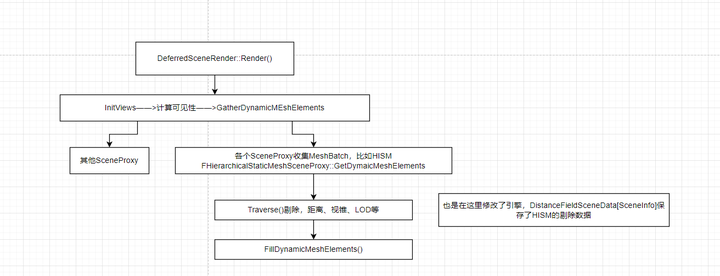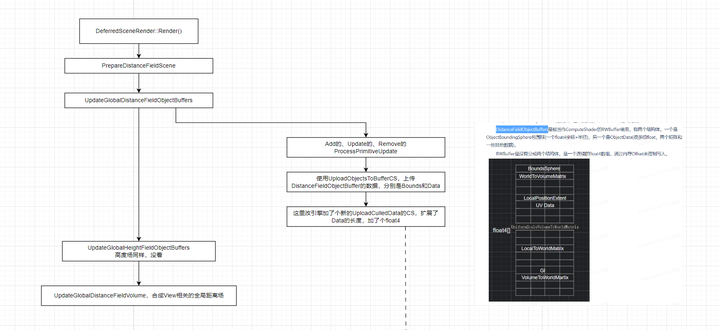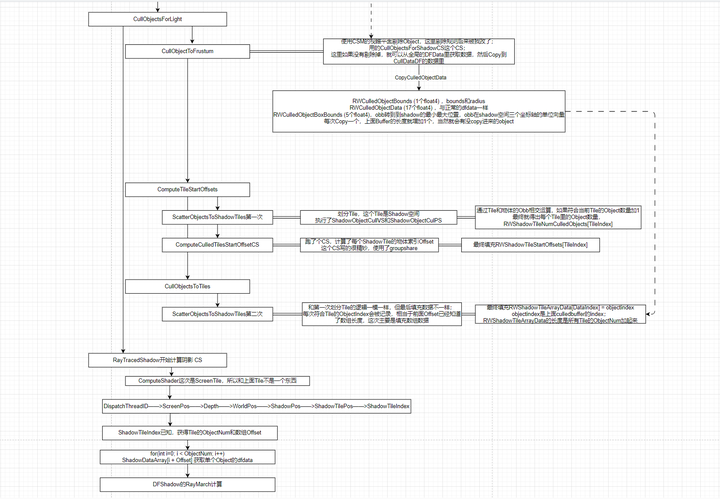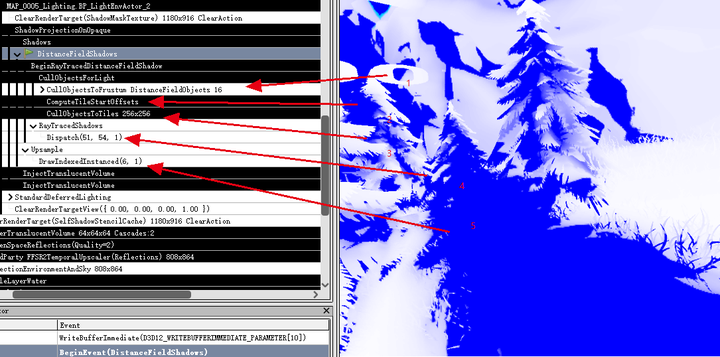1.UE的DistanceField 距离场的生成,有MeshDistanceField和GlobalDistanceField
UE的主要应用是DFShadow、DFAO、材质DistanceFieldToNearest
https://dev.epicgames.com/documentation/en-us/unreal-engine/mesh-distance-fields-in-unreal-engine
2.DFShadow流程 SceneProxy 收集MeshBatch DistanceField数据上传 这一步上传所有SceneProxy的相关距离场数据,一堆float4的数据。
上传Buffer用的是一个ComputeShader,后来改引擎的时候又加了一个ComputeShader用来单独上传Buffer里的某段数据,来更新东西实现功能。
DFShadow计算 DFShadow在光照阶段计算,共有3步:剔除划分->计算阴影->上采样并合并CSM
1.CullObjectsForLight-剔除划分Tile阶段 CullObjectToFrustum :
————使用的CullObjectsForShadowCS这个CS剔除,没剔除的就把这些数据Copy到新的Buffer里
ComputeTileStartOffsets:计算每个Tile相交的Object,并把Object分配到这些Tile里,记录下Tile的索引Offset
————第一次ScatterObjectsToShadowTiles:计算出来每个Tile里有多少个Object
————ComputeCulledTileStartOffsetCS:计算每个Tile的索引Offset
CullObjectsToTiles:
————第二次ScatterObjectsToShadowTiles:前面知道了每个Tile的Object数量和Tile的Offset,这里最后主要是把RWShadowTileArrayData[DataIndex]填充了,它的长度是所有Tile的Object数量之和,它的值是ObjectIndex(就是CullObjectToFrustum这步的CopyData的索引)
RenderDoc上看的流程:
2.DFShadow计算 1 2 3 4 5 6 7 8 9 10 11 12 13 14 15 16 17 18 19 20 21 22 23 24 25 26 27 28 29 30 31 32 33 34 35 36 37 38 39 40 41 42 43 44 45 46 47 48 49 50 51 52 53 54 55 56 57 58 59 [numthreads(THREADGROUP_SIZEX, THREADGROUP_SIZEY, 1)] void DistanceFieldShadowingCS( uint3 GroupId : SV_GroupID, uint3 DispatchThreadId : SV_DispatchThreadID, uint3 GroupThreadId : SV_GroupThreadID) { //和其他ComputeShader算法一样,转换DispatchThreadId为屏幕UV和屏幕坐标 uint ThreadIndex = GroupThreadId.y * THREADGROUP_SIZEX + GroupThreadId.x; float2 ScreenUV = float2((DispatchThreadId.xy * DownsampleFactor + ScissorRectMinAndSize.xy + .5f) * View.BufferSizeAndInvSize.zw); float2 ScreenPosition = (ScreenUV.xy - View.ScreenPositionScaleBias.wz) / View.ScreenPositionScaleBias.xy; //深度转换为世界坐标 float SceneDepth = CalcSceneDepth(ScreenUV); float3 OpaqueWorldPosition = mul(float4(ScreenPosition * SceneDepth, SceneDepth, 1), View.ScreenToWorld).xyz; //得到DFTrace的射线起点和终点,其实就是往灯光方向去打射线,和ContactShadow一样 float3 WorldRayStart = OpaqueWorldPosition + LightDirection * RayStartOffset; float3 WorldRayEnd = OpaqueWorldPosition + LightDirection * TraceDistance; //遍历所有的CullObject,先判断射线是否与物体包围盒相交 //IntersectionTimes得到最近交点和最远交点 float2 IntersectionTimes = LineBoxIntersect(...); BRANCH if (IntersectionTimes.x < IntersectionTimes.y) { //如果有相交,就在包围盒内RayMarching,逐步采样距离场,如果值小于一个阈值,代表很接近这个物体了,可以结束循环,此时距离场信息作为阴影的值。如果已经RayMarch超出包围盒也结束循环。 LOOP for (; StepIndex < MaxSteps; StepIndex++) { float3 SampleVolumePosition = VolumeRayStart + VolumeRayDirection * SampleRayTime; float3 ClampedSamplePosition = clamp(SampleVolumePosition, -LocalPositionExtent, LocalPositionExtent); float DistanceToClamped = length(ClampedSamplePosition - SampleVolumePosition); float3 VolumeUV = DistanceFieldVolumePositionToUV(ClampedSamplePosition, UVScaleAndVolumeScale.xyz, UVAddAndSelfShadowBias.xyz); float DistanceField = SampleMeshDistanceField(VolumeUV, DistanceFieldMAD).x + DistanceToClamped; MinDistance = min(MinDistance, DistanceField); float SphereRadius = clamp(TanLightAngle * SampleRayTime, VolumeMinSphereRadius, VolumeMaxSphereRadius); float StepVisibility = max(saturate(DistanceField / SphereRadius), SelfShadowVisibility); MinConeVisibility = min(MinConeVisibility, StepVisibility); float StepDistance = max(abs(DistanceField), MinStepSize); SampleRayTime += StepDistance; // Terminate the trace if we are fully occluded or went past the end of the ray if (MinConeVisibility < .01f || SampleRayTime > IntersectionTimes.y * VolumeRayLength) { break; } } MinConeVisibility = min(MinConeVisibility, (1 - StepIndex / (float)MaxSteps)); } return MinConeVisibility; }
3.UpSample 和 合并CSM RenderRayTracedDistanceFieldProjection()
1 2 3 4 5 6 7 8 9 10 11 12 13 14 15 16 17 void DistanceFieldShadowingUpsamplePS( in float4 UVAndScreenPos : TEXCOORD0, in float4 SVPos : SV_POSITION, out float4 OutColor : SV_Target0) { float2 DistanceFieldUVs = UVAndScreenPos.xy - ScissorRectMinAndSize.xy * View.BufferSizeAndInvSize.zw; float SceneDepth = CalcSceneDepth(UVAndScreenPos.xy); float Output = Texture2DSampleLevel(ShadowFactorsTexture, ShadowFactorsSampler, DistanceFieldUVs, 0).x; float FarBlendFactor = 1.0f - saturate((SceneDepth - FadePlaneOffset) * InvFadePlaneLength); Output = lerp(1, Output, FarBlendFactor); float NearBlendFactor = saturate((SceneDepth - NearFadePlaneOffset) * InvNearFadePlaneLength); Output = lerp(1, Output, NearBlendFactor); OutColor = EncodeLightAttenuation(half4(Output, Output, Output, Output)); }



